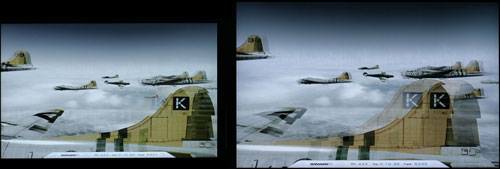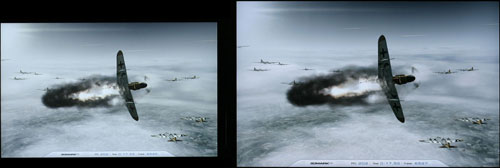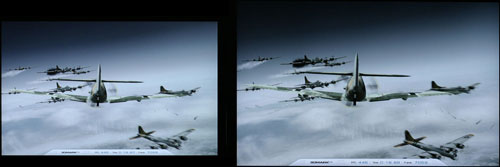HP LP3065: A new contender for the 30" throne
by Jarred Walton on March 22, 2007 7:00 AM EST- Posted in
- Displays
Response Times and Buffering
A topic that almost always comes up as a problem with LCDs is their slower response times relative to CRTs. There's no doubt that even the best LCDs still exhibit some slight pixel smearing, but the vast majority of users are okay with the level of performance we have available now. Image retention on your retinas also occurs to some extent, so even if you can completely eliminate the smearing effect at the display level you won't necessarily see a perfectly crisp transition.
Besides lag at the pixel level, there has also been discussion about a buffering lag that occurs within the LCD before the image is ever sent to the panel for output. This can be particularly noticeable on some HDTVs when connected to a computer, as HDTVs will often do a significant amount of image processing. Whether or not delays are caused by the internal circuitry or by the LCD crystal matrix taking a moment to align itself isn't really important; the end result is what matters, so a display that updates quicker is usually preferred, especially by gamers.
The Dell 2407WFP and Gateway FPD2485W LCDs advertise 16ms TrTf and 6ms GTG response times. The older Dell 2405FPW comes with a 12ms TrTf and 16ms GTG response time, which is sort of the opposite of what we see on most current displays. The 3007WFP lists 14ms TrTf and 11ms GTG, while the newer 3007WFPHC and the HP LP3065 rate 12ms TrTf and 8ms GTG response times. The Acer AL2216W comes with the fastest advertised response time of the displays we've tested so far, boasting a 5ms GTG response time, but it doesn't explicitly state a TrTf value. There are of course other LCDs that are rated even faster, and ratings aren't always accurate, so let's see how these displays compare in practical use.
We used the Dell 2407WFP as the "baseline" display, so it is on the left in all of the following images. We then started the first game demo from 3DMark03 and took numerous pictures, after which we selected several representing the best and worst case results that we could find. With all of the LCDs running a 60 Hz refresh rate, new frames are sent to the display every 0.017 seconds, so that's our granularity. Pay attention to the value of the Time field in the following screenshots, as that will show whether the two displays are showing the same frame or not. Results for the other displays are available at the following links:
Acer AL2216W #1 Acer AL2216W #2
Dell 2405FPW #1 Dell 2405FPW #2
Dell 3007WFP #1 Dell 3007WFP #2
Gateway FPD2485W #1
Despite having the highest rated response times, the Acer AL2216W display actually appears slightly worse than most of the other displays in terms of response times. Internal lag, on the other hand, puts the Acer display at the top of the list, followed closely by both 30" displays. Between the two 30" displays, the LP3065 appears to suffer from less internal lag, consistently running about one frame ahead of the 2407WFP. However, pixel lag appears to be slightly worse on the LP3065, and there are several images where we can see very clear transitions.
Having said that, we never noticed any problems with pixel smearing during subjective testing, and it was only when we resorted to using a camera that we could capture the slight differences between the displays. It's entirely possible that we're getting old so that our eyes aren't bothered by a difference of 0.017 seconds. We strongly feel that most people won't have a problem with the slight image smearing that occurs on these LCDs, but this is something that will vary by individual. If you know you are bothered by image smearing, try out a display in person to see if it's suitable for your needs.
A topic that almost always comes up as a problem with LCDs is their slower response times relative to CRTs. There's no doubt that even the best LCDs still exhibit some slight pixel smearing, but the vast majority of users are okay with the level of performance we have available now. Image retention on your retinas also occurs to some extent, so even if you can completely eliminate the smearing effect at the display level you won't necessarily see a perfectly crisp transition.
Besides lag at the pixel level, there has also been discussion about a buffering lag that occurs within the LCD before the image is ever sent to the panel for output. This can be particularly noticeable on some HDTVs when connected to a computer, as HDTVs will often do a significant amount of image processing. Whether or not delays are caused by the internal circuitry or by the LCD crystal matrix taking a moment to align itself isn't really important; the end result is what matters, so a display that updates quicker is usually preferred, especially by gamers.
The Dell 2407WFP and Gateway FPD2485W LCDs advertise 16ms TrTf and 6ms GTG response times. The older Dell 2405FPW comes with a 12ms TrTf and 16ms GTG response time, which is sort of the opposite of what we see on most current displays. The 3007WFP lists 14ms TrTf and 11ms GTG, while the newer 3007WFPHC and the HP LP3065 rate 12ms TrTf and 8ms GTG response times. The Acer AL2216W comes with the fastest advertised response time of the displays we've tested so far, boasting a 5ms GTG response time, but it doesn't explicitly state a TrTf value. There are of course other LCDs that are rated even faster, and ratings aren't always accurate, so let's see how these displays compare in practical use.
We used the Dell 2407WFP as the "baseline" display, so it is on the left in all of the following images. We then started the first game demo from 3DMark03 and took numerous pictures, after which we selected several representing the best and worst case results that we could find. With all of the LCDs running a 60 Hz refresh rate, new frames are sent to the display every 0.017 seconds, so that's our granularity. Pay attention to the value of the Time field in the following screenshots, as that will show whether the two displays are showing the same frame or not. Results for the other displays are available at the following links:
Acer AL2216W #1 Acer AL2216W #2
Dell 2405FPW #1 Dell 2405FPW #2
Dell 3007WFP #1 Dell 3007WFP #2
Gateway FPD2485W #1
 |
 |
 |
| HP LP3065 |
Despite having the highest rated response times, the Acer AL2216W display actually appears slightly worse than most of the other displays in terms of response times. Internal lag, on the other hand, puts the Acer display at the top of the list, followed closely by both 30" displays. Between the two 30" displays, the LP3065 appears to suffer from less internal lag, consistently running about one frame ahead of the 2407WFP. However, pixel lag appears to be slightly worse on the LP3065, and there are several images where we can see very clear transitions.
Having said that, we never noticed any problems with pixel smearing during subjective testing, and it was only when we resorted to using a camera that we could capture the slight differences between the displays. It's entirely possible that we're getting old so that our eyes aren't bothered by a difference of 0.017 seconds. We strongly feel that most people won't have a problem with the slight image smearing that occurs on these LCDs, but this is something that will vary by individual. If you know you are bothered by image smearing, try out a display in person to see if it's suitable for your needs.










44 Comments
View All Comments
JarredWalton - Thursday, March 22, 2007 - link
I tried to get one and Apple declined. I think Anand has their original version, but that has been outdated by newer releases. If Apple updates their 30" display again, I will see if they're interested in sending one for review.FXi - Thursday, March 22, 2007 - link
The brightness is too low. And the benefit (the wider gamut) is harder to gain the advantage of visually than losing the brightness. In fact it is likely the older 3007FP is a better screen in practical use than the 3007FPHC.I'm not talking TV levels here like 500-550 cd/m2, but rather that 400-450 wasn't bad, and as the backlights degrade slowly over time, effectively give a nice lifespan if you aren't using them in bright environments.
The cost of adding a few extra DVI-D inputs is so cheap it's a travesty they weren't included in every 30" model. PIP might be genuinely useful on a screen this size, so there's another area where the scaling and picture circuitry would be useful. In fact, skip the USB bus entirely and at least give me two, or three DVI-D ports instead.
Probably I missed how you approached it but I saw no direct mention of screen uniformity, which has been a bother in earlier 30" models.
I would add the Samsung 305T and XL30 (when it arrives) to show the full gamut of these size screens. A LOT of folks are commenting that the increased color gamut isn't all that noticeable or useful due partially to a lack of good standards on the pc side to utilize that gamut. 120hz is going to happen faster to smaller displays (sorry) because a DVI-D might have enough bandwidth to drive lower res at double the refresh. I'm not perfectly familiary with the overhead needs, but the bandwidth will be there first, not first in larger displays and moving down. This again points to the use of a 32" 1080P 120hz screen utilizing a card that had HDMI 1.3 output as your fastest way of getting to the 120hz goodness if that is what you seek. Otherwise you'll have to wait a few years.
Core things that need to happen to 30" in general:
400-450 brightness
OSD's
Scaling chips and alternate/multiple inputs
LED backlights (as practical - and not for the gamut increased but the better contrast ratio, screen uniformity and lifespan)
Faster and more consistent (better profiled acceleration) TrTf and GtG speeds
Color accuracy and grey accuracy put ahead of gamut changes. Meaning gamut is useful to a small degree, but the end user is going to appreciate careful color filters and lcd pixel (gray) accuracy more than just increased gamut.
Loved reading these article, because you don't just cover the 30's or the newest 2407 but also the older models, so people can see if the "switch up" is worth the $$.
Thanks!
AnnonymousCoward - Thursday, March 22, 2007 - link
Thanks so much for the review. But I gotta give criticism on the timing, since this is perhaps the best computer display ever, and you waited over 4 months after it came out to review it. Yet when it comes to video cards or CPUs, you review them immediately, sometimes before they're even released! A display is equally important to those components.JarredWalton - Thursday, March 22, 2007 - link
If you look at our display reviews, you'll notice that we only recently started doing these again. The first recent display review was in late February, and since then we've been trying to grow the display reviews section aggressively. Hopefully we will get future displays around launch time, now that we're recommitted to the section. Not surprisingly, HP wasn't really pushing to get us a 30" LCD for a launch-date review when we hadn't covered any LCDs recently. :)chakarov - Friday, March 23, 2007 - link
In your review you say that there isn't much difference between HP's LP3065 and old Dell 3007 WFP. While this would be very informative for some people a few weeks ago now this information is of no value any more because now Dell is selling only their new model 3007 WFP-HC which is comparative in price to LP3065.Now people should decide between support, design, one or three DVI connectors and price.
JarredWalton - Saturday, March 24, 2007 - link
I thought that was the point I made (second paragraph, page 2) - that the new 3007WFP-HC is basically the same panel as the HP model. It's also why I recommend the HP over the Dell, as the multiple inputs seems like a lot more value added than a flash reader, and the price is now the same. (If you can find the older 3007WFP for less money, that's definitely a good choice as well!)AnnonymousCoward - Saturday, March 24, 2007 - link
chakarov's point is that the late-ness of this review is especially critical because there's apparently not much difference between the LP3065 ($1700) and the original 3007WFP ($1274); but a week ago Dell stopped selling that and now only offers a $1700 30" model. It would have been nice to know there's hardly any difference between 11/1/06 and 3/20/07.But again, thanks for doing the review and it's great =)
Oh btw, the HC can be had for $1430+tax if you buy through Dell's small business outlet.
Sceptor - Thursday, March 22, 2007 - link
Buy this and use three 19" or 20" LCD's and get surround gaming and multi monitor support for almost the same price...now DVI.http://www.matrox.com/graphics/en/gxm/products/th2...">Multi LCD Goodness!!
Just my 2 cents...
AnnonymousCoward - Thursday, March 22, 2007 - link
Here's 3 more reasons: watching movies, Photoshopping in full screen, and having 1600 vertical pixels to view webpages or write code with.JarredWalton - Thursday, March 22, 2007 - link
There are several reasons to get a single large LCD instead of multiple smaller LCDs. First, panel quality is going to be a factor, although you should be able to find very good quality 19" LCDs. Second, some people just hate having a black "gap" in their display area. Third, widescreen gaming has become more common, but there are still plenty of games that don't properly support widescreen resolutions. Consider DICE's Battlefield series -- all of them -- where they crop the resolution on widescreen outputs. If you were to run Battlefield 2 at 3840x1024 (assuming it would even work at all), you would probably end up with 3840x2880 and the game would crop the top and bottom 928 pixels!Matrox has a list of http://www.matrox.com/graphics/en/gxm/products/th2...">supported games, and not surprisingly none of the Battlefield games show up. In fact, there are a whole lot of games that aren't listed. Personal preference obviously plays a part, but I would rather have one large LCD than three smaller LCDs. If you disagree and are interested in surround gaming, by all means consider the Matrox TripleHead2Go.